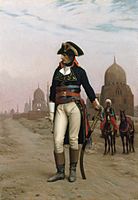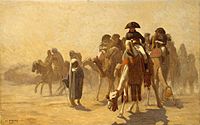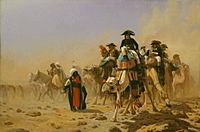Bonaparte Before the Sphinx facts for kids
Quick facts for kids Bonaparte Before the Sphinx |
|
|---|---|
 |
|
| Artist | Jean-Léon Gérôme |
| Year | 1886 |
| Medium | Oil on canvas |
| Dimensions | 61.6 cm × 101.9 cm (24.3 in × 40.1 in) |
| Location | Hearst Castle, San Simeon, California |
This painting, called Bonaparte Before the Sphinx, was made in 1886 by a French artist named Jean-Léon Gérôme. It is also known by its French title, Oedipus (Œdipe). The artwork shows Napoleon Bonaparte during his trip to Egypt. He is on a horse, looking at the famous Great Sphinx of Giza, with his army behind him.
The painting was first shown in Paris at an art show called the Salon in 1886. It was titled Œdipe then, which connects it to an old Greek story about Oedipus and the Sphinx. This painting helped make the image of Napoleon in front of the Sphinx very popular in art. Today, you can see it at the Hearst Castle in California.
What is the Oedipus and Sphinx Story?
When Gérôme named his painting Oedipus, he was thinking about an ancient Greek myth. He also thought about how other artists had shown this story before.
In the myth, a creature called the Sphinx guarded the road to the city of Thebes. The Sphinx would ask a riddle to everyone who passed by. If they could not answer correctly, they would die.
The Sphinx's riddle was: "What has a voice and walks on four legs in the morning, on two at noon, and on three in the evening?" Oedipus answered that it was a human being. As a baby, a person crawls on all fours. As an adult, they walk on two legs. In old age, they might use a stick as a third leg.
This story shows how smart Oedipus was. It also shows a person facing their future. Oedipus solving the riddle led him to become king of Thebes. This myth was not often painted for a long time, but it became very interesting to artists in the 1800s.
Napoleon's Adventures in Egypt by Gérôme
In the 1860s, Gérôme started painting scenes of Napoleon during his campaign in Egypt from 1798-1799. He returned to this topic in the 1880s. He even made a sculpture called Napoleon Entering Cairo, which was shown in 1897.
Gérôme was a great artist to show Napoleon's time in Egypt. He was already famous for his paintings of Egyptian life and landscapes. He had traveled there many times since the mid-1850s.
Gérôme's paintings of Napoleon often show him deep in thought. This is different from many war paintings that show battles or heroes fighting. For example, in Napoleon in Egypt (1863), the young general is alone, thinking deeply. His horse and groom wait nearby.
Another painting, Napoleon and His General Staff in Egypt (around 1867), shows the very tough conditions Napoleon's army faced. They were in Egypt for a short time, and the campaign did not go well. The painting shows the intense heat and the burning sand. It also shows how tired the soldiers were. Napoleon, however, seems to be dreaming of bigger things, like Alexander the Great or Caesar.
Bonaparte in Cairo is a painting that goes well with Bonaparte Before the Sphinx. They are the same size and were sold together to Hearst. When you see them side by side, you can notice the differences. In one, Napoleon looks up at the mysterious Sphinx. In the other, he looks down at the city of Cairo, which he had conquered.
In 1897, Gérôme made a sculpture of young Bonaparte entering Cairo in 1798. This was the first of several sculptures of famous historical figures on horseback that Gérôme created. Other sculptures included Washington, Frederick the Great, Caesar, and Tamerlane. A critic at the time said that Gérôme showed his skill and refined taste as a sculptor with this Napoleon statue. The French government bought the original sculpture. Later, copies were made in different sizes.
More Paintings by Gérôme
-
Napoleon and his General Staff in Egypt (oil sketch), 1863, at the Hermitage Museum.






